The MENA Syringes & Cannula market is witnessing steady growth driven by increasing demand for safe, sterile, and single-use medical devices across healthcare facilities. The future outlook for this market is shaped by rising awareness about infection control, growing healthcare infrastructure, and increasing prevalence of chronic and infectious diseases in the region. Investments in hospital expansions, clinics, and specialized medical centers are enhancing the adoption of disposable medical products.
Additionally, regulatory emphasis on patient safety and strict compliance standards is reinforcing the shift from reusable to single-use syringes and cannulas. The growth of outpatient procedures, vaccination drives, and the increasing volume of diagnostic and therapeutic interventions have further fueled demand.
The market is also benefiting from technological advancements in device design, making syringes and cannulas safer and more user-friendly for both medical professionals and patients As the healthcare sector in MENA continues to modernize, the Syringes & Cannula market is poised for sustained expansion, with disposable and institutional-focused distribution channels driving revenue growth.
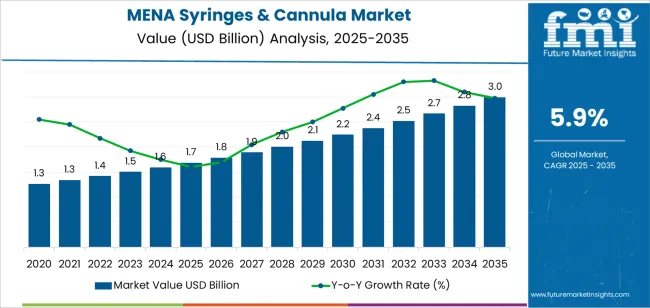
| Metric | Value |
|---|---|
| MENA Syringes & Cannula Market Estimated Value in (2025 E) | USD 1.7 billion |
| MENA Syringes & Cannula Market Forecast Value in (2035 F) | USD 3.0 billion |
| Forecast CAGR (2025 to 2035) | 5.9% |
The market is segmented by Product, Usage, and Distribution Channel and region. By Product, the market is divided into Syringes and Cannula. In terms of Usage, the market is classified into Disposable and Reusable. Based on Distribution Channel, the market is segmented into Institutional Sales and Retail Sales. Regionally, the market is classified into North America, Latin America, Western Europe, Eastern Europe, Balkan & Baltic Countries, Russia & Belarus, Central Asia, East Asia, South Asia & Pacific, and the Middle East & Africa.
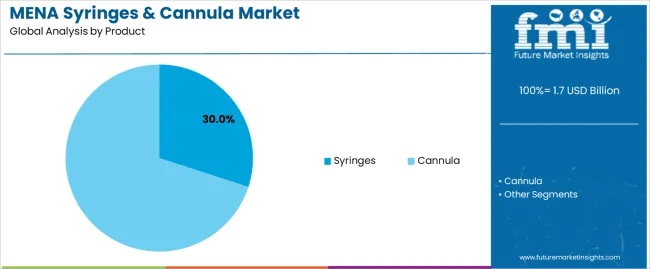
The syringes product segment is projected to hold 30.0% of the MENA Syringes & Cannula market revenue share in 2025, making it a leading product type. This segment has been driven by the critical role syringes play in routine medical procedures, vaccinations, and drug administration.
The demand has been reinforced by the growing focus on safety and prevention of cross-contamination, which has accelerated the adoption of high-quality disposable syringes. In addition, the convenience, reliability, and ease of use associated with syringes support their widespread utilization in hospitals, clinics, and other healthcare facilities.
The segment’s growth is further bolstered by ongoing medical campaigns, increasing patient volumes, and awareness programs emphasizing hygiene and infection control Enhanced manufacturing practices and stringent quality standards have also improved product reliability, encouraging healthcare providers to invest in syringe solutions to ensure safe and efficient patient care.
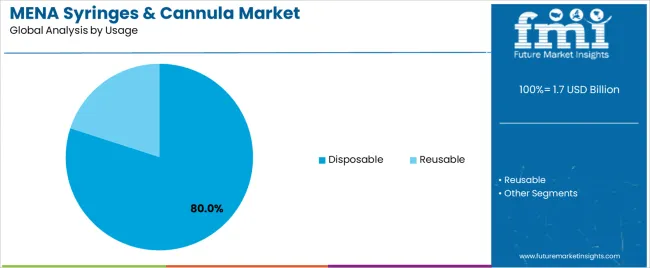
The disposable usage segment is expected to capture 80.0% of the market revenue share in 2025, highlighting its dominance over reusable devices. The preference for disposable syringes and cannulas has been fueled by concerns regarding patient safety and the prevention of healthcare-associated infections.
Disposable devices reduce the risk of contamination and simplify sterilization protocols, which is especially crucial in high-volume healthcare settings. The adoption is further reinforced by regulatory guidelines promoting single-use products in clinical and surgical environments.
The segment’s growth is also supported by the rising number of outpatient procedures, immunization programs, and diagnostic interventions that require reliable, ready-to-use devices As healthcare facilities continue to prioritize operational efficiency and infection control, disposable syringes and cannulas are expected to maintain a strong presence in the market.
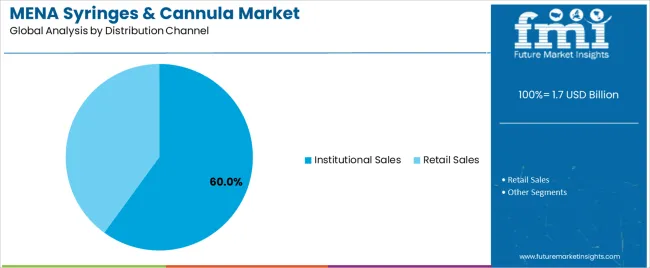
The institutional sales distribution channel segment is anticipated to account for 60.0% of the market revenue in 2025, making it the leading channel for syringes and cannulas. This growth is driven by large-scale procurement by hospitals, clinics, and government health agencies that require bulk supply of sterile and disposable medical devices.
Institutional purchasing ensures consistent quality, compliance with regulatory standards, and cost-effectiveness in managing large patient volumes. The channel’s prominence is further supported by strategic partnerships between manufacturers and healthcare institutions, enabling reliable supply and timely distribution.
Additionally, the increasing focus on public health initiatives and vaccination campaigns in the MENA region has reinforced institutional reliance on high-quality syringes and cannulas The scalability and efficiency of this distribution model continue to drive revenue growth and reinforce the dominance of institutional sales in the market.
The below table presents the expected CAGR for the MENA syringes & cannula market over several semi-annual periods spanning from 2025 to 2035. In the first half (H1) of the decade from 2025 to 2035, the business is predicted to surge at a CAGR of 6.9%, followed by a slightly lower growth rate of 6.3% in the second half (H2) of the same decade.
| Particular | Value CAGR |
|---|---|
| H1 | 6.9% (2025 to 2035) |
| H2 | 6.3% (2025 to 2035) |
| H1 | 5.9% (2025 to 2035) |
| H2 | 5.5% (2025 to 2035) |
Moving into the subsequent period, from H1 2025 to H2 2035, the CAGR is projected to increase slightly to 5.9% in the first half and remain relatively moderate at 5.5% in the second half. In the first half (H1) the market witnessed a decrease of 100 BPS while in the second half (H2), the market witnessed a decrease of 110 BPS.
Rising Prevalence of Infectious Diseases and Other Medical Condition Anticipates the Growth of the Market
The rising prevalence of infectious disease in the MENA region are majorly attributed to the factors such as poverty, poor healthcare systems, and overcrowding. The common disease in the region are tuberculosis, dengue, malaria, and hepatitis B. The region also has a high incidence of respiratory infections and parasitic diseases such as schistosomiasis.
For instance, according to the statistics published by the World Health Organization in 2024, a total number of 230,121 cases of cholera were reported in Yemen. The statistics also stated that Somalia had 6,582 suspected cases of cholera in the same year.
In addition to this, the increase in number of a serious infection such as Human Immunodeficiency Virus (HIV) has also been observed in the region. The major reason for increase in HIV cases in the region is lack of education and knowledge on sexually transmitted diseases. For instance, according to the statistics published by the United Nations, the Middle East and North Africa (MENA) region has the highest number of new HIV infections globally, with an estimated 420,000 new cases in 2024 alone among which men are mostly affected accounting for 76.0% of the cases in the region.
These rising prevalence of infectious diseases in the region majorly surges the growing demand of syringes and cannula in the market.
Growing Advancements in Syringes and Cannulas Contributes to its Growing Adoption
The introduction of safety-equipped syringes, such as those with passive needle guards and upgraded retractable needle systems, has improved the prevention of needle-stick injuries and reduced the risk of unintentional needle stick injury.
Manufacturers are introducing advanced lubrication technology that have improved ease of use as compared to the traditional ones. This technology have also reduced the risk of needle stick injuries associated with syringes. Companies are also focusing on the development of novel smart syringes that can prevent contact induced infections when injected into muscles or skin.
In addition to this, the growing adoption of multi-chamber syringes with enhanced efficiency and safety of syringe use, particularly in the administration of multiple medications further propels the rising competition of developing advanced syringes and cannulas among operating players.
Dependency of MENA Region on Imports of Medical Supplies Constrains the Market Growth
MENA region is largely dependent on imports of medical supplies which leads hospitals and other healthcare facilities to incur higher costs on supplies such as syringes and cannulas. These costs are generally high due to the inclusion of high tariffs, shipping fees and currency fluctuations. These increased cost makes syringes and cannula less affordable to healthcare facilities operating in the countries which significantly hampers its adoption in the market and limits its growth in the market.
In addition to this, lack of availability of any strong local manufacturing player in the market further exacerbates the issue. Availability of only few domestic manufacturers the region struggles to meet the growing demand of medical supplies which makes them highly dependent on external suppliers.
These dependency on external suppliers exposes MENA region to intense competition among global suppliers that can hamper the growth of local businesses. These factors may also lead to increase in number of suppliers that are offering sub-standard medical supplies to the market that are inconsistence, affecting the reliability and safety of medical supplies.
Growing Awareness for the Injuries Caused Due to Syringes and Cannula
Growing safety awareness is a crucial issue in the MENA region. These injuries can be severe and life-threatening, and they often occur due to improper handling, storage, and disposal of medical equipment. To address this issue, various organizations and governments in the MENA region are implementing measures to promote safety awareness and provide training to healthcare professionals on proper handling of these kind of medical devices.
There are also additional efforts taken by the clinical practitioners to ensure that the medical equipment’s they are using are properly sterilized. Therefore, an overall efforts taken by the healthcare professionals on educating and training their clinical staff on improving the overall quality of healthcare of the MENA region contributes to the growth in demand of syringes and cannula.
The MENA syringes & cannula industry recorded a CAGR of 4.7% during the historical period between 2020 and 2025. The growth of syringes & cannula market is positive as it reached a value of USD 1,503.5 million in 2025 from USD 1,181.9 million in 2020.
The syringes & cannula market experienced positive growth attributed to the rising ageing population suffering from various chronic disorders, increase in number of patients undergoing medical procedures, growing advancements in syringes and cannulas with an aim of preventing injuries at healthcare facilities and the continuously developing healthcare infrastructure. For instance, according to the World Bank the share of UAE’s ageing population i.e., above the age of 65 is projected to increase by 4.4% by 2035.
These developing healthcare infrastructure in the region has brought new job opportunities for many of the upcoming healthcare practitioners who are willing to start their career at the international forefront. For instance, according to an article published by Alpen Capital, Dubai will require an additional number of 8,300 physicians and 8,800 nurses by the year 2025.
Development of these advanced healthcare infrastructure has also made it a great spot for medical tourism. For instance, the UAE Ministry of Economy report have demonstrated that the sales of medical tourism in UAE were estimated to be USD 1.6 billion in 2024 which are projected to grow to by 17.1% between 2024 and 2025. These growing healthcare infrastructure has led to an increase in demand for medical supplies that are advanced, safe and have reduced risk of needle-stick injuries.
To meet this growing demand many of the national players who are exporting medical supplies to the MENA region have introduced advanced syringes and cannula technology that are safely engineered. These are few of the factors that are significantly contributing to the growing adoption of syringes and cannula in the MENA market.
Tier 1 companies consist of market leaders with a market revenue of above USD 100 million and holds a market share of 15% to 20% in global market. These market leaders have high production capacities and has a wide range of product portfolio to offer in the market. These players also has strong geographical presence with their growing emphasis on expansion of their distribution network in emerging nations. Prominent companies within tier 1 include Becton, Dickinson, and Company, Cardinal Health, and B. Braun Medical Inc.
Tier 2 companies include mid-size players with revenue of USD 50 to 100 million having presence in specific countries and have ability to influence the local market. These players are have strong local network in hospital and other healthcare facilities and poses advanced technology that are required for the manufacturing of products. The companies in tier 2 include Ambu A/S, Nipro Corporation, Terumo Corporation, and Medline Industries Inc. etc.
Tier 3 includes the small-scale companies operating at the local level. These companies have customer base of local healthcare facilities. They are small-scale players and have limited market reach. Tier 3, companies are recognized as unorganized market, as they have limited production facility as compared to organized competitors.
The section below covers the industry analysis for the MENA syringes and cannula market for different countries. Market demand analysis on key countries in several countries of the MENA, including Saudi Arabia, Turkey, Algeria, Iran, Israel and others, is provided. Qatar is anticipated to grow at a maximum growth rate of 9.0% during the forecast period.
| Countries | Value CAGR (2025 to 2035) |
|---|---|
| Saudi Arabia | 5.3% |
| Turkey | 4.2% |
| UAE | 6.1% |
| Egypt | 5.4% |
| Morocco | 8.7% |
| Qatar | 9.0% |
| Kuwait | 6.9% |
Saudi Arabia syringes and cannula market is poised to exhibit a CAGR of 5.3% between 2025 and 2035 and is projected to reach USD 3 million by the end of 2035. The country currently holds the largest market share of 15.8% and the trend is expected to continue during the forecast period.
The rapid urbanization and economic development in the Saudi Arabia country have led to an increase in number of people following sedentary lifestyle. These increased number of people following sedentary lifestyle has led to a rising prevalence of chronic disease such as diabetes and hypertension among growing population.
In addition to this, an increase in ageing population suffering from chronic disease and comorbidities have led to an increased need of developing a robust healthcare infrastructure which is efficient to deliver an effective healthcare service to the patient population of the country.
These factors has encouraged many private healthcare facility investors to invest in construction of advanced medical facilities. These investors are also emphasizing on installation of technologically advanced medical equipment’s are further propelling the growth of the market in the region. For instance, in March 2025, HSBC Bank Middle East Limited published an article which stated that there are more than 161 healthcare projects in GCC that are under pipeline.
In addition to this, the growing emphasis of regulatory authorities on improving accessibility of healthcare facilities in the underserved areas of the region further augment the growth of the market. . In October 2025, Saudi Arabia health ministry announced that it would give a green light to over 100 projects in next five years.
Turkey currently holds around 12.4% share of the MENA syringes & cannula market. The market is anticipated to grow at a CAGR of 4.2% throughout the forecast period.
Several initiatives launched by Turkish government for improving the healthcare services and infrastructure in the country has primarily contributed to the growth of the syringes and cannula market in the country. These initiatives are majorly aimed to expand their existing healthcare facilities by constructing new hospitals and clinics.
For instance, according to an article published by the Prime Property Turkey Limited, in August 2025, Turkish president Recep Tayyip Erdogan is working on an initiative of building more hospitals in the country is underway. The initiative of building more hospitals is aimed to revitalize healthcare system for general population through city hospitals.
Moreover, the country has also emerged as a popular destination for the medical tourism as they have number of surgeons equipped with technologically advanced facilities. For instance, according to an article published by JOURNAL OF SOCIETY, ECONOMICS AND MANAGEMENT in June 2025, Türkiye has become one of the most optimal destination for medical tourism for medical treatments such as orthopedics, cardiology, and cosmetic surgery.
The section contains information about the leading segments in the industry. By product, the syringes segment accounted for a market share of 73.7% in 2025 and is anticipated to grow at a significant CAGR during the forecast period.
| Material | Syringes |
|---|---|
| Value Share (2025) | 73.7% |
The syringes segment dominates the market in terms of revenue. The segment accounted for almost 73.7% of the market share in 2025 and is projected to grow at a significant growth rate during the forecast period. The dominance in revenue share is owing to the growing adoption of syringes for the management of pain and other chronic conditions such as diabetes.
In addition to this, growing use of syringes in wide variety of medical procedures such as administration of injections, drawing blood and delivering medications makes use of syringe a staple product in the healthcare settings. Moreover, increasing use of injectable medications including vaccines and biologics due to growing focus of government on launching immunization programs for the treatment of chronic diseases further contributes to its increasing demand in the market.
In addition to this, increasing awareness of needle safety and the need to prevent needle-stick injuries have emphasized manufacturers to focus on development of syringes that have improved safety measures and are efficient for healthcare providers.
| Usage | Disposable |
|---|---|
| Value Share (2025) | 68.6% |
The disposable segment accounted for a revenue share of over 68.6% in the MENA syringes and cannula market and is poised to expand at a significant CAGR across the forecast period. The development of safety measures like passive needle guards and improved retractable needle systems is addressing the concern of needle-stick injuries, making disposable syringes more attractive.
The segment has witnessed a significant growth owing to its increased adoption among healthcare facilities for preventing cross-contamination of any disease among patients. Moreover, use of disposable syringes eliminates the cost of sterilization which makes it a cost-effective solution for healthcare facilities and contributes to its increased adoption.
The number of vaccination drives sponsored by government and non-government organizations has increased significantly in MENA, resulting in increased demand for disposable syringes and cannula.
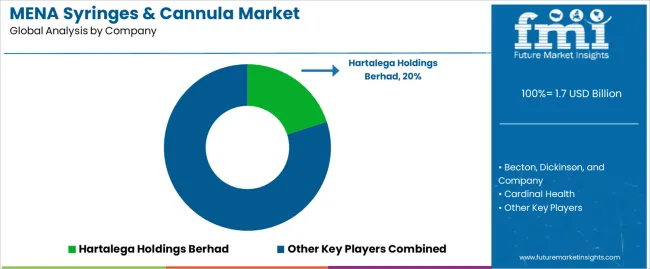
Key players operating in the syringes and cannula market are emphasizing on expansion of their geographical presence by expanding their direct sales channel and distributors network. Key players have also involved in making strategic collaboration for launch of their new products to the market.
Recent Industry Developments in MENA Syringes and Cannula Market
In terms of product, the industry is divided into syringes (disposable hypodermic syringes, auto disposable syringes, safety syringes, prefilled syringes, insulin syringes), and cannula (neonatal cannula, straight cannula, winged cannula, cannula with wings & port, cannula with integrated stop cock, nasal cannula)
In terms of usage, the industry is segregated into reusable and disposable.
The industry is classified distribution channel as institutional sales (hospitals, ambulatory surgical centres, office-based clinics, skilled nursing facilities & long term care centres, diagnostic laboratories and academic and research institutions), retail sales (retail pharmacies, drug stores, retail stores {hypermarket/supermarket}, online sales)
Key countries of MENA, including Algeria, Iran, Israel, Egypt, UAE, Saudi Arabia, Morocco, Kuwait, Qatar, Turkey, and Rest of MENA have been covered in the report.
The global mena syringes & cannula market is estimated to be valued at USD 1.7 billion in 2025.
The market size for the mena syringes & cannula market is projected to reach USD 3.0 billion by 2035.
The mena syringes & cannula market is expected to grow at a 5.9% CAGR between 2025 and 2035.
The key product types in mena syringes & cannula market are syringes, _disposable hypodermic syringes, _auto disposable syringes, _safety syringes, _prefilled syringes, _insulin syringes, cannula, _neonatal cannula, _straight cannula, _winged cannula, _cannula with wings & port, _cannula with integrated stop cock and _nasal cannula.
In terms of usage, disposable segment to command 80.0% share in the mena syringes & cannula market in 2025.






Full Research Suite comprises of:
Market outlook & trends analysis
Interviews & case studies
Strategic recommendations
Vendor profiles & capabilities analysis
5-year forecasts
8 regions and 60+ country-level data splits
Market segment data splits
12 months of continuous data updates
DELIVERED AS:
PDF EXCEL ONLINE
MENASA Commercial Vehicle Market Size and Share Forecast Outlook 2025 to 2035
MENA Industrial Packaging Market Size and Share Forecast Outlook 2025 to 2035
MENA POU Water Purifier Market : Trends, Growth & Forecast 2025 to 2035
Menadione Market
Europe and MENA Generic Oncology Drug Market Size and Share Forecast Outlook 2025 to 2035
Middle East/North Africa (MENA) Commercial Vehicles Market Analysis - Size, Share, and Forecast 2025 to 2035
Cloud Storage Industry Analysis in MENA Size and Share Forecast Outlook 2025 to 2035
MENA Digital Transformation Industry Analysis – Trends & Forecast 2024-2034
Syringes and Injectable Drugs Packaging Market Size and Share Forecast Outlook 2025 to 2035
Syringes Market Analysis - Growth & Demand 2025 to 2035
BFS Syringes Market Analysis - Size & Growth Forecast 2025 to 2035
Hypodermic Syringes Market Size and Share Forecast Outlook 2025 to 2035
Analyzing Hypodermic Syringes Market Share & Industry Leaders
Veterinary Syringes Market
Europe Glass Prefilled Syringes and Glass Vials Packaging Equipment Market Analysis – Outlook & Forecast 2025–2035
Latin America Hypodermic Syringes and Needles Market Analysis & Forecast by Type, End Users, and Region Through 2035
Retractable Needle Safety Syringes Market Size and Share Forecast Outlook 2025 to 2035
Cyclic Olefin Polymers (COP) Polymer Syringes Market Size and Share Forecast Outlook 2025 to 2035
Sustainable Label Market Forecast Outlook 2025 to 2035
HR Tech Market Forecast Outlook 2025 to 2035

Thank you!
You will receive an email from our Business Development Manager. Please be sure to check your SPAM/JUNK folder too.
Chat With
MaRIA